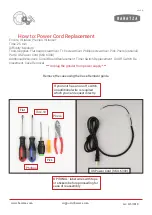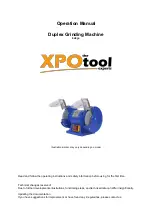
Instruction Manual
Section Five
secondary relief was ground first. The width of the primary land
need not exceed 1/16 inch. After the primary relief has been ground
on the side and front end of the cutter, grind the necessary nose
radius between the two lands. Hold the tool lightly and rotate it
in a full arc from the side to the front while against the wheel face.
III. SALVAGING TOOLS
A. Salvaging End Mills —Using A Standard Cut-Off Wheel:
1. Mount the cutter in a standard universal workhead with the mill axis
parallel to the table travel. Lock the workhead spindle. Mount a standard
6 x 1/16 or 1/32 inch cut-off wheel to the grinder spindle. Mount a wheel
guard. A K. O. Lee wheel, such as the PR6AH70 (S.F.P.M. @ 6.000),
can be used for this operation. Wheel bond may be shellac, rubber, or
resin. Insure that there is sufficient machine Crossfeed travel to pass the
wheel through the mill. The swivel can be used to position the cutter
axis closer to the wheel spindle. Position the wheel periphery just back
of the broken tooth and center the wheel center height with that of the
workhead. Start the wheel motor in the "forward" direction. Use the
machine Crossfeed to move the wheel through the mill as rapidly as the
wheel can cut. Moving the wheel through the cutter too slowly will burn
the cutter by glazing the wheel.
NOTE:
The following alternate methods
may be used:
(a) Set the wheel spindle at 90 degrees to the table using the trans
mission as a means of power to pass the wheel through the end mill.
In the latter case, the workhead spindle is also rotated 90 degrees
relative to the table.
(b) Mount larger cutters or cutters which tend to heat during static
cut-off in a motorized workhead at the left end of the table. Mount
the wheel in the usually cylindrical grinding position. Rotate the
cutter in the opposite direction to that of the wheel at the point
of contact and cut rapidly through the mill.
2. If the peripheral flutes need gumming, perform this operation at this
point using the method described in B-2 below.
3. Grind the teeth end clearances by the following general outline.
(a) Although it is usually not necessary, some end mill usage may require
the center portion of the end being relieved. In this case, mount
a small straight wheel or cup wheel and plunge grind the center
portion of the mill to desired relief depth and diameter.
(b) Set the end of the mill in relation to a cup or saucer wheel as
shown in Photo 68. Initially tilt the workhead up to place the
desired primary clearance land on the cutter. Note that the tooth
rest is mounted on the workhead with the upright shaft extended
through the bottom of the toothrest base. The spring-blade microm
eter is used for direct indexing on the teeth faces The outer edge
of the cup wheel should have a small radius dressed on it. The
wheel elevation must be located so that the O.D. of the wheel will
create the desired form for the end face of the tooth following the
one on which the clearance is being ground. Set a table stop to
achieve the same form depth on all teeth. The wheel O.D. should
extend to the mill center, if no center relief is ground. After com-
- 8 8 -
















































